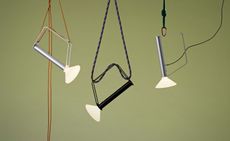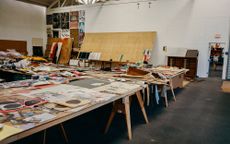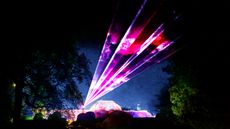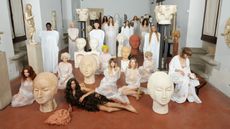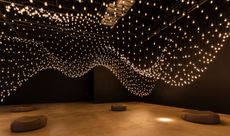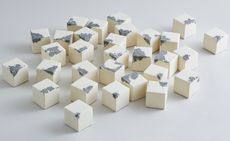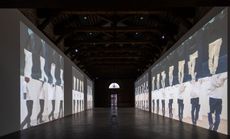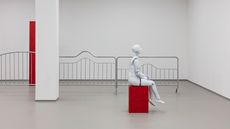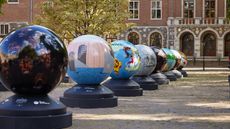Happy hour: a vibrant clock tower installation tops off Galeria Leme
- (opens in new tab)
- (opens in new tab)
- (opens in new tab)
- Sign up to our newsletter Newsletter
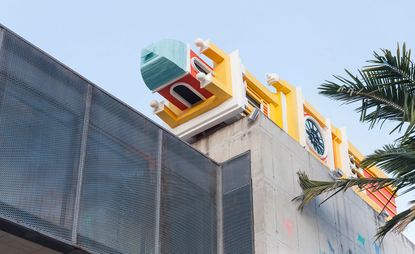
São Paulo’s Galeria Leme, a key player in Brazil’s innovative art scene, has gained a colourful new appendage. As part of the gallery’s ‘SITU’ project – where Latin American artists develop site-specific works on the theme of urban space – artist Pilar Quinteros has constructed a tongue-in-cheek clock tower on the gallery’s roof.
Don’t be tricked by the playful, primary colours of Quinteros’ new installation – this is serious stuff. As curator Bruno de Almeida explains, by laying the ‘subverted’ clocktower sideways, Quinteros is making a philosophical comment on ‘the conquered supremacy of time over space and its consequences on our built environment’.
Designed by the godfather of Brazilian brutalism, Paulo Mendes da Rocha, the grey gallery building is at odds with its vibrant new addition. Despite their aesthetic differences, the two structures share historical parallels. Both, in one way or another, were at one time situated somewhere else.

‘Situ 6: Friends of Perpetual Movement’, by Pilar Quinteros.
Quinteros’ installation is a replica of the clock tower at Luz train station – one of São Paulo's most storied buildings. Designed by quintessential Victorian architect Charles Henry Driver at the end of the 19th century in Glasgow, the station was imported to Brazil piece by piece. Galeria Leme has a similarly pre-fabricated past. The original gallery was dismantled in 2011 (just a few short months after it was built) because the plot was bought by a commercial construction company. In 2012, a new, near-identical version (also designed by Mendes da Rocha) was reconstructed down the road.
‘I was very interested in the shared aspects of the history of both buildings,’ Quinteros offers. ‘But at the same time, the longer I spent working on this project the more I got interested in the station’s clock tower as a symbol. The Luz Station is one of the most emblematic buildings in São Paulo but paradoxically it has an European origin. I believe this metaphorically represents the history of our continent.’
Time, too, is a European construct, thinks Quinteros. ‘The clock tower symbolically implements a sort of global order – standard time and the time-zone system also originated in Europe.’ Significantly, Quinteros’ clock doesn’t tick. The 9m long, volumetric rendition of Luz clock tower replaces any intricate internal mechanisms with foam blocks, surrounded by a crude wooden structure and supportive scaffolding – easily dismantled; easily re-installed elsewhere.

The artist explains: ‘The clock tower symbolically implements a sort of global order – standard time and the time-zone system also originated in Europe’

By laying the ‘subverted’ clocktower sideways, Quinteros is making a philosophical comment on ‘the conquered supremacy of time over space’

Designed by the godfather of Brazilian brutalism, Paulo Mendes da Rocha, the grey gallery building is at odds with its vibrant new addition

View of the installation from the courtyard

The project is part of the gallery’s ‘SITU’ programme, where Latin American artists develop site-specific works on the theme of urban space
INFORMATION
‘SITU 6: Friends of Perpetual Movement’ is on view until July. For more information, visit the Galeria Leme website (opens in new tab)
ADDRESS
Galeria Leme
Avenue Valdemar Ferreira 130
Butantã
São Paulo
VIEW GOOGLE MAPS (opens in new tab)
Elly Parsons is the Digital Editor of Wallpaper*, where she oversees Wallpaper.com and its social platforms. She has been with the brand since 2015 in various roles, spending time as digital writer – specialising in art, technology and contemporary culture – and as deputy digital editor. She was shortlisted for a PPA Award in 2017, has written extensively for many publications, and has contributed to three books. She is a guest lecturer in digital journalism at Goldsmiths University, London, where she also holds a masters degree in creative writing. Now, her main areas of expertise include content strategy, audience engagement, and social media.
-
 Luxury loungewear brands to hibernate in this winter
Luxury loungewear brands to hibernate in this winterAs days get shorter and temperatures drop, we present the best loungewear for luxuriating in this autumn and winter, from brands including Loro Piana, Raey, Extreme Cashmere and more
By Tilly Macalister-Smith • Published
-
 Portable lights to illuminate your winter nights
Portable lights to illuminate your winter nightsThe best portable lights and where to buy them: brighten up your winter evenings with this edit of portable lamps for your desk, garden and more
By Rosa Bertoli • Published
-
 Last chance to see: Sterling Ruby’s ‘Turbines’ at Gagosian New York, marked here by our visit to the artist’s LA studio
Last chance to see: Sterling Ruby’s ‘Turbines’ at Gagosian New York, marked here by our visit to the artist’s LA studioStep inside American artist Sterling Ruby’s studio, divided into distinct areas of operation
By Hunter Drohojowska-Philp • Published
-
 The best 7 Christmas installations in London for art lovers
The best 7 Christmas installations in London for art loversAs London decks its halls for the festive season, explore our pick of the best Christmas installations for the art-, design- and fashion-minded
By Harriet Lloyd-Smith • Published
-
 Vanessa Beecroft’s ethereal performance and sculpture exhibition explore Sicily’s cultural history
Vanessa Beecroft’s ethereal performance and sculpture exhibition explore Sicily’s cultural historyAt the historic Palazzo Abatellis, Sicily, Vanessa Beecroft has unveiled ‘VB94’, a new tableau vivant comprising a one-time performance and a new series of sculptures, the latter on view until 8 January
By Hili Perlson • Published
-
 London art exhibitions: a guide for this week
London art exhibitions: a guide for this weekYour guide to the best London art exhibitions, and those around the UK, as chosen by the Wallpaper* arts desk
By Harriet Lloyd Smith • Last updated
-
 Rafael Lozano-Hemmer’s Pulse Topology in Miami is powered by heartbeats
Rafael Lozano-Hemmer’s Pulse Topology in Miami is powered by heartbeatsRafael Lozano-Hemmer brings heart and human connection to Miami Art Week 2022 with Pulse Topology, an interactive light installation at Superblue Miami in collaboration with BMW i
By Fiona Mahon • Last updated
-
 Textile artists: the pioneers of a new material world
Textile artists: the pioneers of a new material worldThese contemporary textile artists are weaving together the rich tapestry of fibre art in new ways
By Harriet Lloyd-Smith • Published
-
 Bruce Nauman’s Venice mega-show is a full body experience
Bruce Nauman’s Venice mega-show is a full body experienceFocusing on the American artist's performative 'Contrapposto Studies', Bruce Nauman's show at Punta della Dogana, Venice, gives new meaning to body language – on view until 27 November 2022
By Laura May Todd • Published
-
 Tora Schultz: ‘Bitch on Wheels’ is a surreal, witty take on a world designed for the male body
Tora Schultz: ‘Bitch on Wheels’ is a surreal, witty take on a world designed for the male bodyFrom crash test dummies to pitchfork stilettos, Tora Schultz’s show ‘Bitch on Wheels’ at Copenhagen’s O–Overgaden is a tragic comedy exploring gender bias, stereotypes, and the surrealism of everyday life
By Alice Godwin • Published
-
 The World Reimagined revisits the history of the transatlantic slave trade through art
The World Reimagined revisits the history of the transatlantic slave trade through artAhead of a Bonhams auction on 21 November, The World Reimagined will conclude with an epic finale in Trafalgar Square this weekend (19 and 20 November). The initiative uses art to illuminate the history of the transatlantic slave trade, inviting us ‘to face our shared history with honesty, empathy and grace’.
By Amah-Rose Mcknight Abrams • Published

